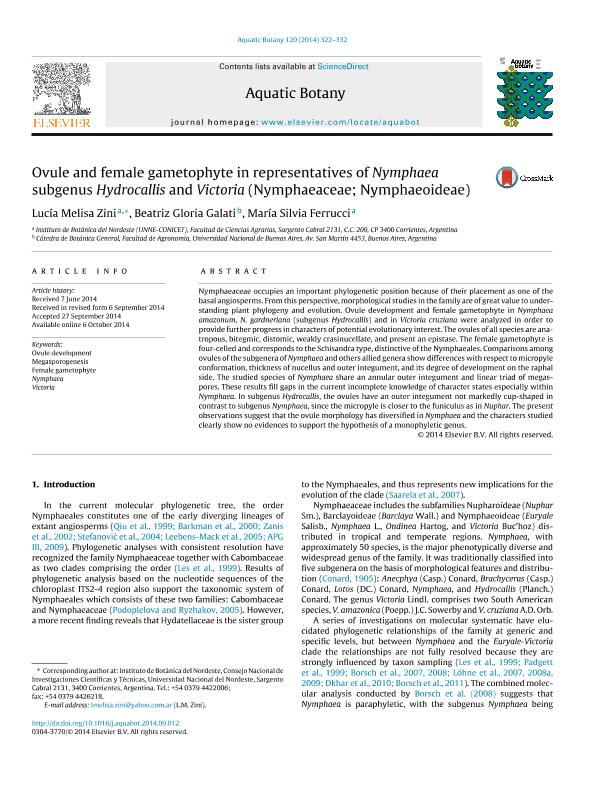Mostrar el registro sencillo del ítem
dc.contributor.author
Zini, Lucia Melisa

dc.contributor.author
Galati, Beatriz Gloria

dc.contributor.author
Ferrucci, María Silvia

dc.date.available
2016-08-08T20:07:20Z
dc.date.issued
2015-10
dc.identifier.citation
Zini, Lucia Melisa; Galati, Beatriz Gloria; Ferrucci, María Silvia; Ovule and female gametophyte in representatives of Nymphaea subgenus Hydrocallis and Victoria (Nymphaeaceae; Nymphaeoideae); Elsevier Science; Aquatic Botany; 120; Part B; 10-2015; 322-332
dc.identifier.issn
0304-3770
dc.identifier.uri
http://hdl.handle.net/11336/7008
dc.description.abstract
Nymphaeaceae occupies an important phylogenetic position because of their placement as one of the basal angiosperms. From this perspective, morphological studies in the family are of great value to understanding plant phylogeny and evolution. Ovule development and female gametophyte in Nymphaea amazonum, N. gardneriana (subgenus Hydrocallis) and in Victoria cruziana were analyzed in order to provide further progress in characters of potential evolutionary interest. The ovules of all species are anatropous, bitegmic, distomic, weakly crasinucellate, and present an epistase. The female gametophyte is four-celled and corresponds to the Schisandra type, distinctive of the Nymphaeales. Comparisons among ovules of the subgenera of Nymphaea and others allied genera show differences with respect to micropyle conformation, thickness of nucellus and outer integument, and its degree of development on the raphal side. The studied species of Nymphaea share an annular outer integument and linear triad of megaspores. These results fill gaps in the current incomplete knowledge of character states especially within Nymphaea. In subgenus Hydrocallis, the ovules have an outer integument not markedly cup-shaped in contrast to subgenus Nymphaea, since the micropyle is closer to the funiculus as in Nuphar. The present observations suggest that the ovule morphology has diversified in Nymphaea and the characters studied clearly show no evidences to support the hypothesis of a monophyletic genus.
dc.format
application/pdf
dc.language.iso
eng
dc.publisher
Elsevier Science

dc.rights
info:eu-repo/semantics/openAccess
dc.rights.uri
https://creativecommons.org/licenses/by-nc-nd/2.5/ar/
dc.subject
Ovule Development
dc.subject
Megasporogenesis
dc.subject
Female Gametophyte
dc.subject
Nymphaea
dc.subject
Victoria
dc.subject.classification
Ciencias de las Plantas, Botánica

dc.subject.classification
Ciencias Biológicas

dc.subject.classification
CIENCIAS NATURALES Y EXACTAS

dc.title
Ovule and female gametophyte in representatives of Nymphaea subgenus Hydrocallis and Victoria (Nymphaeaceae; Nymphaeoideae)
dc.type
info:eu-repo/semantics/article
dc.type
info:ar-repo/semantics/artículo
dc.type
info:eu-repo/semantics/publishedVersion
dc.date.updated
2016-07-26T15:09:22Z
dc.journal.volume
120
dc.journal.number
Part B
dc.journal.pagination
322-332
dc.journal.pais
Países Bajos

dc.journal.ciudad
Amsterdam
dc.description.fil
Fil: Zini, Lucia Melisa. Consejo Nacional de Investigaciones Científicas y Técnicas. Centro Científico Tecnológico Nordeste. Instituto de Botánica del Nordeste (i); Argentina
dc.description.fil
Fil: Galati, Beatriz Gloria. Universidad de Buenos Aires. Facultad de Agronomia; Argentina
dc.description.fil
Fil: Ferrucci, Maria Silvia. Consejo Nacional de Investigaciones Científicas y Técnicas. Centro Científico Tecnológico Nordeste. Instituto de Botánica del Nordeste (i); Argentina
dc.journal.title
Aquatic Botany

dc.relation.alternativeid
info:eu-repo/semantics/altIdentifier/doi/10.1016/j.aquabot.2014.09.012
dc.relation.alternativeid
info:eu-repo/semantics/altIdentifier/doi/http://dx.doi.org/10.1016/j.aquabot.2014.09.012
dc.relation.alternativeid
info:eu-repo/semantics/altIdentifier/url/http://www.sciencedirect.com/science/article/pii/S0304377014001521
Archivos asociados
